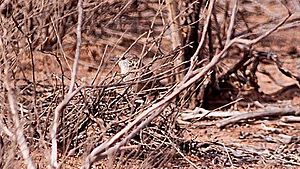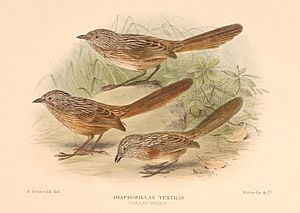Thick-billed grasswren facts for kids
Quick facts for kids Thick-billed grasswren |
|
|---|---|
 |
|
| Conservation status | |
| Scientific classification | |
| Genus: |
Amytornis
|
| Species: |
modestus
|
| Subspecies | |
|
See text |
|
| Synonyms | |
|
|
The thick-billed grasswren (Amytornis modestus) is a small, shy bird that lives only in Australia. It's part of the Maluridae family, which includes many types of wrens. This bird prefers to live in dry, shrubby areas, like those found in Mediterranean-type climates.
Contents
About the Thick-billed Grasswren's Family Tree
For a long time, the thick-billed grasswren was thought to be the same bird as the western grasswren. But in 2010, scientists decided they were different enough to be their own separate species.
Different Types of Thick-billed Grasswrens
Scientists recognize seven different types, or subspecies, of the thick-billed grasswren. Some of these are sadly no longer around:
- †A. m. modestus – This type is now extinct. It used to live in central Australia, in the Northern Territory.
- A. m. indulkanna – You can find this type in central Australia, across the Northern Territory and South Australia.
- A. m. raglessi – This one lives in the Flinders Ranges, a mountain area in central South Australia.
- A. m. curnamona – Found in the Lake Frome Basin, another part of central South Australia.
- A. m. cowarie – This type lives in the Sturt Stony Desert, also in central South Australia.
- A. m. obscurior – You can find this type in New South Wales, in central Australia.
- †A. m. inexpectatus – This type is also extinct. It used to live in New South Wales, central Australia.
What the Thick-billed Grasswren Looks Like
The thick-billed grasswren has dull brown feathers on its belly and a long, dark brown tail. Its head has clear white stripes, which continue down its neck, throat, and back. These white stripes stand out against the bird's reddish-brown or grey feathers.
Male grasswrens have longer tails than females. Females also have a special chestnut (reddish-brown) color on their sides. These birds make short, high-pitched songs that they repeat. They also have a very soft, high-pitched call that humans often can't hear.
Where They Live and What They Like
The thick-billed grasswren lives only in Australia. You can find it in the dry areas of northwestern New South Wales, northern South Australia, and southern parts of the Northern Territory. Some people think there might still be small groups living in the Grey Range of Sturt National Park.
These birds love areas with dense "chenopod" bushes, like saltbush, and also sandhill cane-grass. They often live near dry, sandy creek beds where flood debris piles up. The eastern type of grasswren prefers saltbush, while the western type likes black-bush and Australian boxthorn.
How They Live: Behaviour and Ecology
Thick-billed grasswrens usually stay in one place. These shy birds are often seen running, hopping, or rarely flying, as they try to stay hidden among the plants. They also look for food on the ground around plants.
Their strong, thick beaks allow them to eat tough seeds and other foods that smaller wrens can't. If they get scared, they hide quickly in plants, piles of old flood debris, or even in rabbit burrows.
You'll often see them alone or in pairs. Mating pairs usually keep a territory of about 5 to 40 hectares (about 12 to 100 acres) all year round. They rarely, if ever, join up with other grasswrens outside of breeding season. Sometimes, you might see family groups when the young birds are still learning from their parents. Their feather patterns help them blend in with their surroundings, acting as camouflage.
Reproduction and Life Cycle
Thick-billed grasswrens usually breed between July and September. They build their nests in low branches of saltbush, cane-grass, or similar plants. The nest is shaped like half a dome and is made of loose grass and bark. Inside, it's lined with finer grass, fur, and feathers to make it cozy.
They lay one to three eggs, but usually two. The eggs can be white, cream, or pink, with red-brown or purplish-grey spots. The eggs hatch after about two weeks, and the young birds leave the nest in 10 to 12 days. A thick-billed grasswren typically lives for about four years.
What They Eat
The thick-billed grasswren mainly eats insects and other small creatures without backbones. They also enjoy plant seeds and berries.
Threats to Their Survival
The biggest danger to thick-billed grasswrens is the loss of their homes. This happens when land is cleared or when too many animals, like sheep and goats, eat and trample the plants they need. This reduces the good places for them to live and breed, especially the larger bushes they prefer. Rabbits also change their habitat.
Wild animals like foxes and cats are also a big threat because they hunt the grasswrens. All these problems have become worse because of droughts (long periods without rain) in recent years.
Frequent wildfires are another danger. Too many fires disrupt the grasswrens' life cycle, as well as the plants and insects they rely on. Changes in the weather and environment also make it harder for them to survive.
Conservation Status
The thick-billed grasswren is not a strong flyer, which means it doesn't move far from its home. This makes it very easy for their groups to become separated and isolated.
The government of New South Wales and the Commonwealth of Australia both consider the thick-billed grasswren to be critically endangered. This means they are at a very high risk of disappearing forever. However, the South Australian government and the IUCN Red List (a global list of threatened species) classify it as 'least concern', meaning they are not currently at high risk. The bird was officially protected under a law called the Environmental Protection and Biodiversity Conservation (EPBC) Act in 2009.
See also
 In Spanish: Maluro picogordo para niños
In Spanish: Maluro picogordo para niños



